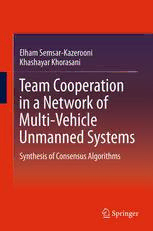
Team Cooperation in a Network of Multi-Vehicle Unmanned Systems: Synthesis of Consensus Algorithms PDF
Preview Team Cooperation in a Network of Multi-Vehicle Unmanned Systems: Synthesis of Consensus Algorithms
Team Cooperation in a Network of Multi-Vehicle Unmanned Systems Elham Semsar-Kazerooni • Khashayar Khorasani Team Cooperation in a Network of Multi-Vehicle Unmanned Systems Synthesis of Consensus Algorithms 123 ElhamSemsar-Kazerooni KhashayarKhorasani UniversityofToronto DepartmentElectrical&Computer Toronto,Canada Engineering ConcordiaUniversity MontrealQue´bec,Canada ISBN978-1-4614-5072-6 ISBN978-1-4614-5073-3(eBook) DOI10.1007/978-1-4614-5073-3 SpringerNewYorkHeidelbergDordrechtLondon LibraryofCongressControlNumber:2012950316 ©SpringerScience+BusinessMediaNewYork2013 Thisworkissubjecttocopyright.AllrightsarereservedbythePublisher,whetherthewholeorpartof thematerialisconcerned,specificallytherightsoftranslation,reprinting,reuseofillustrations,recitation, broadcasting,reproductiononmicrofilmsorinanyotherphysicalway,andtransmissionorinformation storageandretrieval,electronicadaptation,computersoftware,orbysimilarordissimilarmethodology nowknownorhereafterdeveloped.Exemptedfromthislegalreservationarebriefexcerptsinconnection with reviews or scholarly analysis or material supplied specifically for the purpose of being entered and executed on a computer system, for exclusive use by the purchaser of the work. Duplication of this publication or parts thereof is permitted only under the provisions of the Copyright Law of the Publisher’slocation,initscurrentversion,andpermissionforusemustalwaysbeobtainedfromSpringer. PermissionsforusemaybeobtainedthroughRightsLinkattheCopyrightClearanceCenter.Violations areliabletoprosecutionundertherespectiveCopyrightLaw. Theuseofgeneraldescriptivenames,registerednames,trademarks,servicemarks,etc.inthispublication doesnotimply,evenintheabsenceofaspecificstatement,thatsuchnamesareexemptfromtherelevant protectivelawsandregulationsandthereforefreeforgeneraluse. While the advice and information in this book are believed to be true and accurate at the date of publication,neithertheauthorsnortheeditorsnorthepublishercanacceptanylegalresponsibilityfor anyerrorsoromissionsthatmaybemade.Thepublishermakesnowarranty,expressorimplied,with respecttothematerialcontainedherein. Printedonacid-freepaper SpringerispartofSpringerScience+BusinessMedia(www.springer.com) To MyParents,and MyHusband,Amin ElhamSemsar-Kazerooni To MyFamily KhashayarKhorasani Preface Recently,therehasbeenagrowinginteresttowardsdevelopmentofsensornetwork (SN)systems,ormorebroadlydefinedasnetworkofunmannedsystems(NUMS), thatcanoperateautonomouslyforanextendedperiodoftimewithoutanextensive involvementofhumanoperators.Thisareahasattractedasignificantlevelofinterest in the past few years and is currently considered as one of the strategic areas of researchinthefieldofsystemscontroltheory.Themotivationforthisinterestmay betracedto applicationswheredirecthumaninterventionorinvolvementis either notpossibleornotsafeduetoenvironmentalhazards,extraordinarycomplexityof tasks involved, or other restrictions. On the other hand, observations made based on natural behavior of animals operating as a team have inspired scientists in differentdisciplinestoinvestigatethepossibilitiesofnetworkingagroupofsystems (systemofsystems)toaccomplishagivensetoftaskswithoutrequiringanexplicit supervisor.Someexamplesofsuchnaturalbehaviorscanbefoundinthemigration ofbirds,motionoffish searchingforfood,andteamworkofotheranimalswhich haveagrouplivingstyle.Inalltheseexamples,theanimalsworktogetherasateam with an intergroup cooperation and with no supervision from outside the team in ordertoperformtheircomplextasks.Furthermore,itshouldbenotedthatadvances inwirelesscommunicationnetworkshavemadeitfeasibletoconnectanumberof systemsdistributedoveralargegeographicarea. These advances and observations, among other factors, have led the scientists to concentrate and focus on the area of network of unmanned systems. The advantagesof NUMS are numerousand applications in various fields of research arebeingdeveloped.Someoftheadvantagesfordeployingautonomousnetworkof unmannedsystemsareenhancedgrouprobustnesstoindividualfaults,increasedand improvedinstrumentsensingandresolution,reducedcostofoperation,andadaptive reconfigurabilitycapabilities [13]. These networks of dynamical systems are then required and tasked to cooperate in order to accomplish complicated tasks which arehighlynovelandchallengingandwhichotherwisewouldhavebeenimpossible to accomplish by using only a single unit. These networks may be potentially constructedfromintegratingalargenumberofdynamicalsystems(agents),suchas unmannedaerialvehicles(UAVs),unmannedgroundvehicles(UGVs), unmanned vii viii Preface underwater vehicles (UUVs), satellites [as in precision formation flight (PFF)], or mobile robots. Any one of the above systems usually consists of a number of sensors,actuators,anddecisionmakers,andthereforethenetworkofthesesystems isanetworkofpotentiallylargenumberofsensorsandactuators,orasisknownin the literature, a sensor–decider–actuatornetwork. In order to fully take advantage of these large-scale networks, several prerequisites have to be satisfied. Some of these prerequisites are developmentof reliable communication, optimal power consumptionmanagement,security,optimalcooperation,andteamcollaborationas discussedin[119]. Team cooperation and coordination for accomplishing predefined goals and requirementsconstituteasoneofthemainprerequisitesforthesenetworkedmulti- agent systems as they are intended to be deployed in challenging and complex missions. Although,a large bodyof literaturehasfocused on team cooperationin variouscontexts,mostoftheproposedstrategiesarenotbasedonrigoroussynthesis approaches. This book seeks to propose and develop synthesis-based strategies for team cooperation in a network by designing optimal consensus algorithms. Towards this end, a frameworkfor modelling and controlof a network of mobile robots in a cooperative manner is developed. Specifically, two control algorithms are designedforconsensus-seekingproblemin sucha network.First, the problem is solved by utilizing optimal control theory and by solving the corresponding Hamilton–Jacobi–Bellman (HJB) equations. The consensus problem is formally defined and solved for a team of dynamical systems having a linear dynamical model.Stabilityoftheteamisguaranteedbyusingmodifiedconsensusalgorithms that are derived by minimizing a set of individual cost functions. An alternative approach for obtaining an optimal consensus algorithm is presented by invoking a state decomposition methodology and by transforming the consensus-seeking problemintoastabilizationproblem. In the second methodology,the game theoryapproachis used to formulatethe consensus-seeking problem in a strictly cooperative framework. For this purpose, the team cost function is defined and the corresponding min–max problem is solved in order to obtain a cooperative optimal solution. It is shown that the resultsobtainedyield lowercost valueswhencomparedto those thatare obtained by using the optimal control technique. In both approaches based on the game theoryandthestatedecompositiontechnique,linearmatrixinequalitiesareusedto simultaneouslyimpose:(a)thedecentralizedrequirementofthesolutionsoughtand (b) the consensus constraints on the resulting designed controllers. Moreover,the performanceandstabilitypropertiesofthedesignedcooperativeteamareanalyzed inthepresenceofactuatoranomaliescorrespondingtothreetypesoffaults.Steady state behavior of the team members is also analyzed under faulty scenarios. The adaptability of the team members to unanticipated circumstances is demonstrated and verified formally. Finally, the assumption of having a fixed and undirected networktopologyisrelaxedinordertoaddressandsolvemorerealisticandpractical scenarios.Specifically,itisshownthatstabilityandconsensusachievementofthe networksubjecttobothrandomswitchingstructuresandleaderassignmentchanges Preface ix can still be achieved. Moreover, by introducing additional criteria, the desirable performancespecificationsoftheteamcanstillbeensuredandguaranteed. This book is mainly intended and targeted for researchers, scientists, and graduate-level university students who are interested in becoming familiar with designofconsensus-seekingalgorithmsinthegeneralareaofnetworkeddynamical systems.Thefundingformuchoftheresearchreportedinthisbookwasprovided bythesupportfromthenaturalsciencesandengineeringresearchcouncilofCanada (NSERC).Thesecondauthorwouldalsoliketosincerelyacknowledgethefunding support he has received as a Tier I Concordia University Research Chair and the supportfromtheFacultyofEngineeringandComputerScience. Toronto,Canada E.Semsar–Kazerooni Montreal,Canada K.Khorasani
